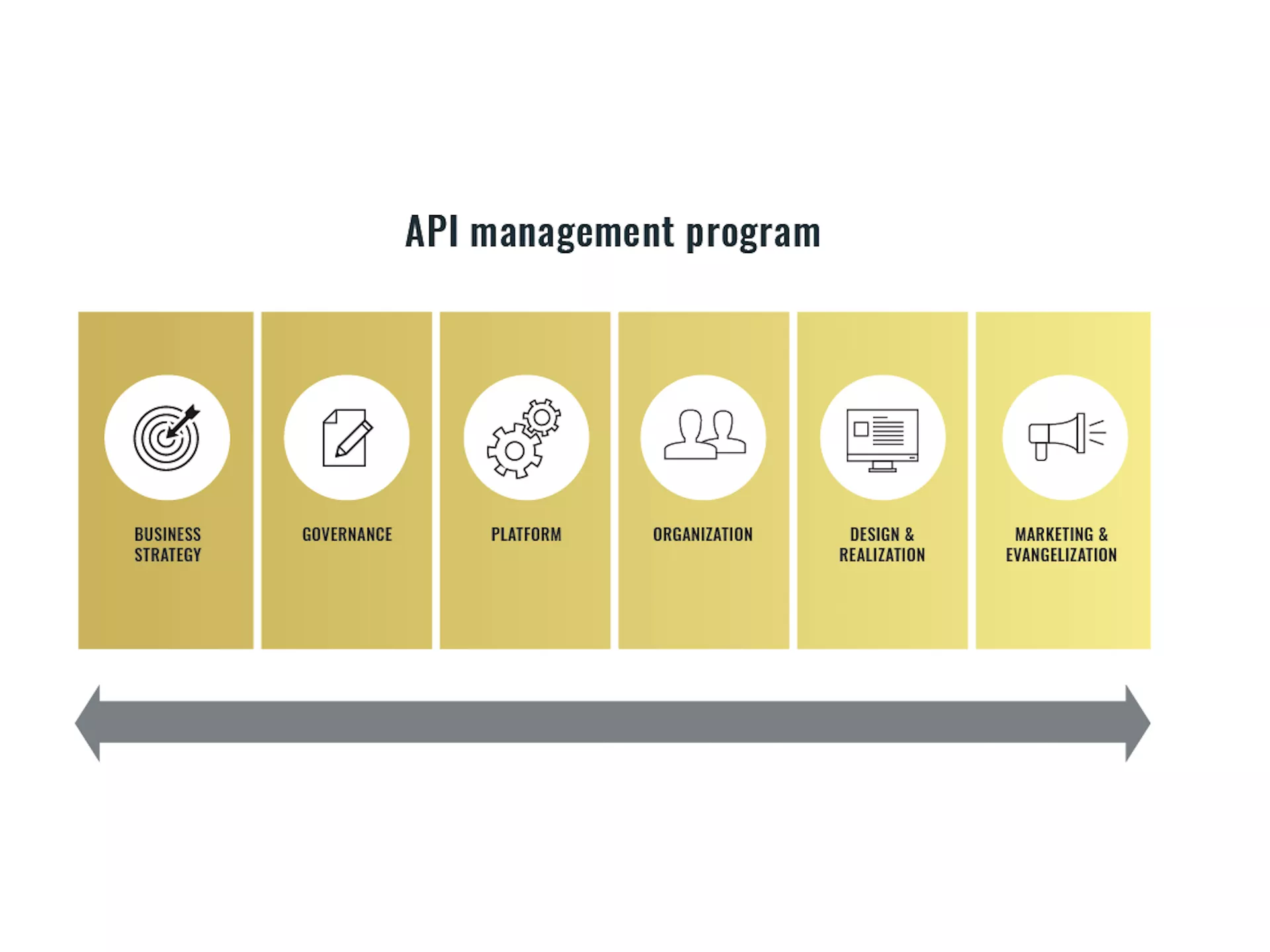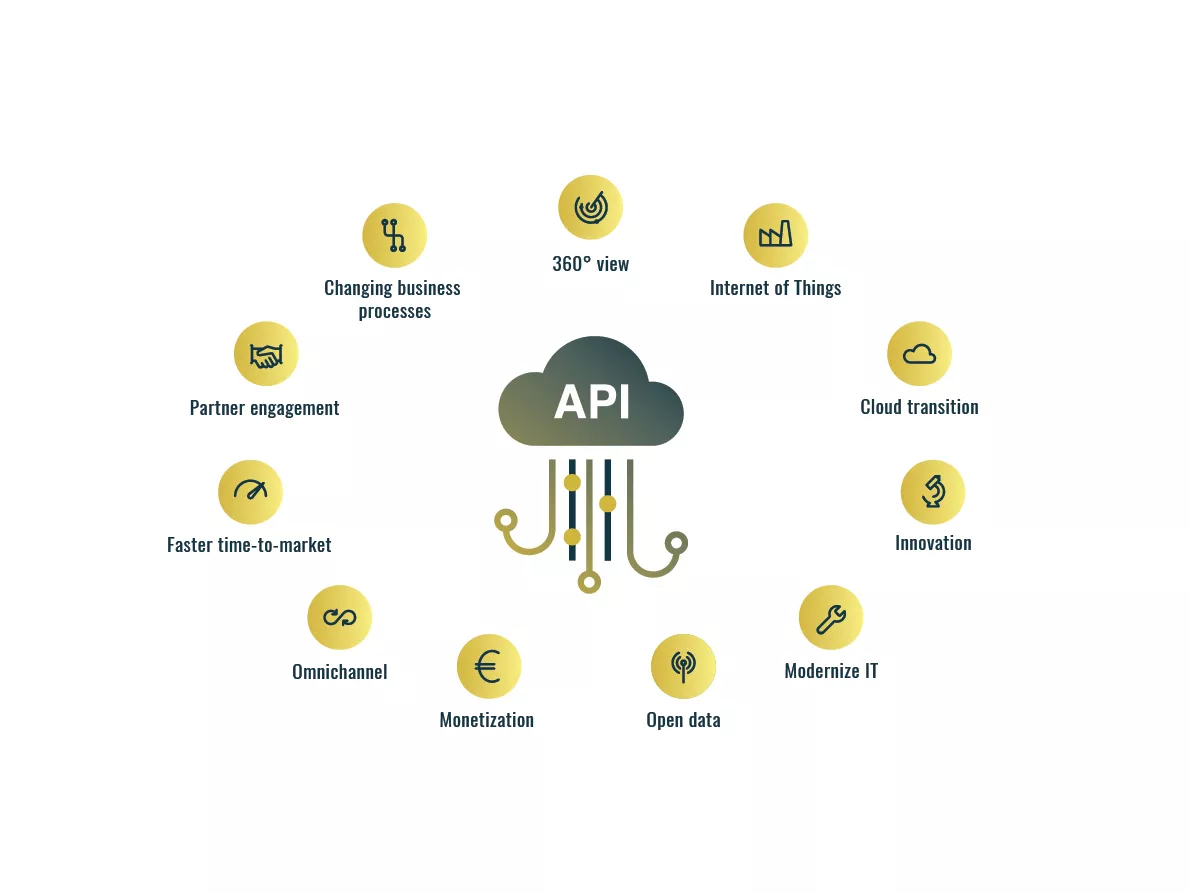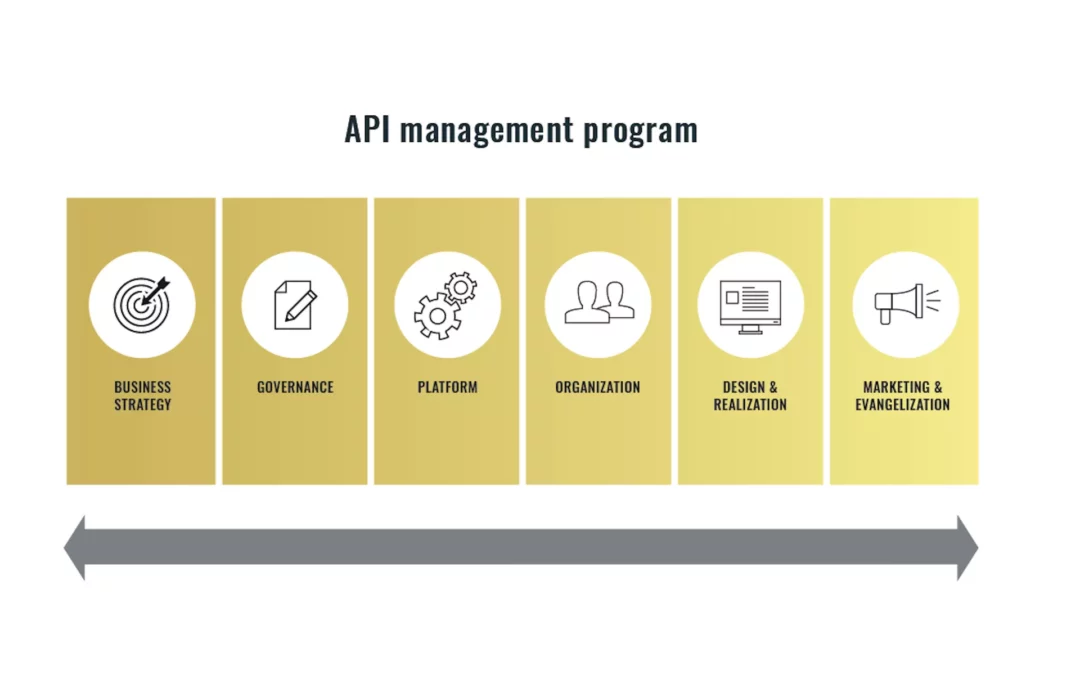Starting with APIs is easy. However, creating a successful API Management program that helps your organization achieve its strategic goals and provides value to customers, is a substantial endeavor. This requires a comprehensive and well-designed approach. Archers has developed such an approach that helps you start small, and let your initiatives grow, while keeping an eye on all the essential aspects that make it a success.
Our approach consists of 6 pillars:
- Strategy
- Governance
- Platform
- Organization
- Design & Realization
- Marketing & Evangelization
API MANAGEMENT PROGRAM

Strategy
An API strategy establishes a direction and outlines a clear path for your API Management program. It brings focus and makes the organization work towards your goals. It ensures that your future APIs bring business and IT value and that they realize your overall business objectives. Early involvement of business and other stakeholders in the API management program will also help adoption within the organization.
In this phase, we will also formulate the business value of APIs in envisioned business models, possible monetization options, identify potential ecosystems, etc. You can take advantage of the opportunity to evangelize all of its benefits and how APIs will fit into the organization.
Your strategy is the starting point of your program. Decisions made here will heavily influence future choices within the other pillars. For example, if monetization is a strategic API driver, then your platform capabilities must support this.
In short, your strategy is about building the right APIs. To formalize a strategy, you must engage with business and IT stakeholders to understand their strategic objectives, challenges, organizational context, industry, market situation, etc. Our API drivers help facilitate these interviews and workshops to translate the objectives of this input into an API strategy. To guarantee long-term success, it is essential to define a set of goals and KPIs to go along with them. This will enable you to create a feedback mechanism to the business and demonstrate the success of the program.

GOVERNANCE
Governance is essential to your API program. It must ensure that all the processes and documentation is in place to realize the strategic goals of the program. We identify two types of governance: operational & strategic.
Operational governance helps you manage the quality of your APIs and whether you are building the right APIs. The depth and breadth of your governance setup will be determined by how detailed and extensive it needs to be. If your approach is too thorough, you could slow the whole process down and prevent adoption throughout the organization.
Strategic governance’s focal point is the KPIs and the progress of the API program in relationship to the business goals. Does your monetization strategy work? Are the expected consumers using your APIs? Are we able to deliver products to the market faster? Business stakeholders must be involved in the API management program by clearly demonstrating the business value it can bring to the organization. Also, it is a great way to detect and discuss new business opportunities for the API platform.
Last but not least is your developer and/ or partner onboarding process. You must make it as convenient and easy as possible to use your APIs through self-service. The number of consumers, registered applications, and usage should give you an idea of how attractive your API offering is.
PLATFORM
The platform is there to support all of the processes, patterns, and documentation. Therefore, the platform must contain all the necessary capabilities to do so.
Here are six capabilities that we believe are essential to your API platform:
- Life Cycle Management
- Developer Enablement
- Security
- Mediation
- Measure
- Monetization
Those skills can be offered by one platform, but other platforms and components can be introduced as well.
It is crucial to make sure that the different platforms and components integrate well within the existing IT landscape. You can do this by assessing the current technology landscape and capabilities, including their limitations. Mapping the required capabilities, based on the APIs and integration flows, onto the existing landscape, will give you an idea of what abilities and technology you are missing.
Once the gap analysis is done, you can continue with the platform selection. Here your IT strategy for procurement and cloud will have an impact. Do you go for a best-of-breed approach, or do you stick to one vendor?
organization
Starting an API management program will have an impact on your organization. It is important that you cover all the bases in terms of responsibilities and roles. Determining who takes ownership of what, is a valuable exercise. You must guarantee that the platform, APIs and processes can be supported, now and in the future.
Another aspect is your relationship with your partners and customers. Making clear where their responsibility starts and ends significantly helps in providing stable APIs. You must take into account the existing organization structure and culture. For example, centrally organized teams require a different approach to decentralized teams.
It’s important to notice that the organization is not only concerned with the more technical aspects, but it must also take into account every business-oriented role. The product mindset must be promoted among the teams and within the organization as it is an essential attribute APIs. Business stakeholder’s involvement and strategic governance should also be high on your list of responsibilities.
Here is a list of roles we believe are essential to the success of your API management program:
- API Product Manager
- API Program Manager
- API Developer
- API Architect
It is crucial to make sure that the different platforms and components integrate well within the existing IT landscape. You can do this by assessing the current technology landscape and capabilities, including their limitations. Mapping the required capabilities, based on the APIs and integration flows, onto the existing landscape, will give you an idea of what abilities and technology you are missing.
Once the gap analysis is done, you can continue with the platform selection. Here your IT strategy for procurement and cloud will have an impact. Do you go for a best-of-breed approach, or do you stick to one vendor?
Design & realization
The assets of the design & realization pillar will help you to speed up the delivery process and deliver standardized APIs. Delivering a standardized API will give your consumers a consistent developer experience and will help to maintain your API landscape more efficiently. API guidelines support your teams in their development effort by giving input for naming conventions, exception handling, versioning, and so forth.
Integration patterns and reference architectures are other significant assets. They serve as blueprints to solve everyday challenges in a uniform manner, supporting the creating of your standardized product.
Special attention must go to security. Exposing your APIs to a variety of known and unknown consumers comes with new risks and challenges. Your API security guidelines and patterns must provide solutions to deal with authentication and authorization of your consumers.
Marketing & evangelization
As stated in the beginning, it is easy to start building APIs. That’s the main reason why organizations end up with API-as-a-solution rather than API-as-a-product. API-as-a-solution takes an outward approach and eventually become technical integration solutions that offer services based on internal functions and data. However, building the right API requires a customer-centric way of thinking, providing value to your customers and achieving business goals. Building the right API will not turn your APIs into products!
With API management, your consumers and the consumer experience are very important. You must make an effort to build a community, both internal and external, around your products. It will help you get feedback about your products and improve where possible. Keeping in touch with business stakeholders will ensure their involvement while you get the chance to demonstrate the business value of the APIs and discover new opportunities.
Implementing an API platform often represents a significant change to the organization. There are new roles and responsibilities, and last but not least, the ever-present product mindset. You should adopt a continuous effort to inform, engage, and challenge your organization to embrace this change.
Many organizations adopt an API-first approach, which means that, when building a product or a service, APIs are on the top of the list. These represents a significant shift in thinking and handling. Therefore, you must provide the necessary resources to get the message out there and realize the change in the organization.
Conclusion:
We’ve discussed all the pillars in the Archers API management program framework. And what should be clear by now, is that they are playing an equally important role.
It all starts with your API strategy that must focus on business and IT goals. From there, you can develop all the other parts. The framework allows you to start small and grown as needed.
Do you have any questions after finishing this blog post about API Management? Is your organization in need of a platform? Or do you like to have advice on achieving your strategic goals? Let’s connect!
Together we’ll create an API program that comprises all activities to make the necessary changes in your enterprise!
Some more integration blogs for you
ALWAYS LOOKING FORWARD TO CONNECTING WITH YOU!
We’ll be happy to get to know you.









